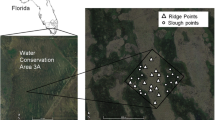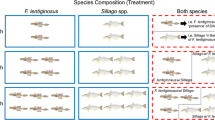Abstract
Seagrass meadows are often important habitats for newly recruited juvenile fishes. Although substantial effort has gone into documenting patterns of association of fishes with attributes of seagrass beds, experimental investigations of why fish use seagrass habitats are rare. We performed two short-term manipulative field experiments to test (1) the effects of food supply on growth and densities of fish, and (2) effects of predation on the density and size distribution of fish recruits, and how this varies among habitat types. Experiments were conducted in Galveston Bay, Texas, and we focused on the common estuarine fish, pinfish Lagodon rhomboides. In the first experiment, replicate artifical seagrass and sand plots were either supplemented with food or left as controls. Recruitment of pinfish was significantly greater to seagrass than sand habitats; however, we detected no effect of food supplementation on the abundance of recruits in either habitat. Pinfish recruits in artifical seagrass grew at a significantly faster rate than those in sand habitats, and fish supplemented with food exhibited a greater growth rate than controls in both sand and artifical grass habitats. In our second experiment, we provided artificial seagrass and sand habitats with and without predator access. Predator access was manipulated with cages, and two-sided cages served as controls. Recruitment was significantly greater to the cage versus cage-control treatment, and this effect did not vary between habitats. In addition, the standard length of pinfish recruits was significantly larger in the predator access than in the predator exclusion treatment, suggesting size-selective predation on smaller settlers or density-dependent growth. Our results indicate that the impact of predation on pinfish recruits is equivalent in both sand and vegetated habitats, and thus differential predation does not explain the higher recruitment of pinfish to vegetated than to nonvegetated habitats. Since predators may disproportionately affect smaller fish, and a limited food resource appears to be more effectively utilized by fish in vegetated than in unvegetated habitats, we hypothesize that pinfish recruits may select vegetated habitats because high growth rates allow them to achieve a size that is relatively safe from predation more quickly.
Similar content being viewed by others
Author information
Authors and Affiliations
Additional information
Received: 10 October 1996 / Accepted: 5 April 1997
Rights and permissions
About this article
Cite this article
Levin, P., Petrik, R. & Malone, J. Interactive effects of habitat selection, food supply and predation on recruitment of an estuarine fish. Oecologia 112, 55–63 (1997). https://doi.org/10.1007/s004420050283
Issue Date:
DOI: https://doi.org/10.1007/s004420050283




